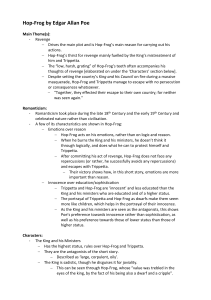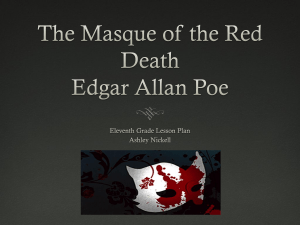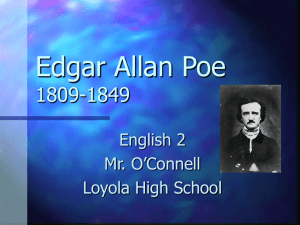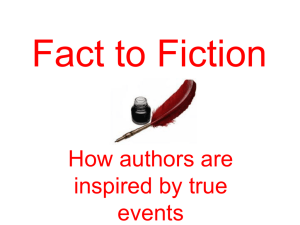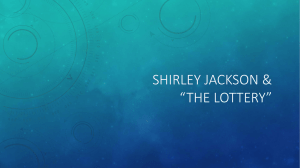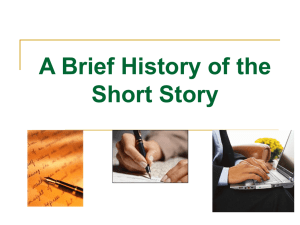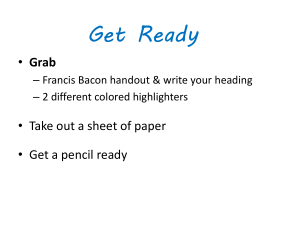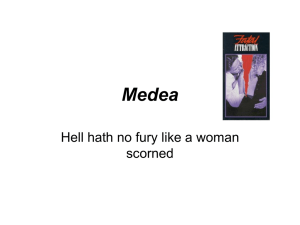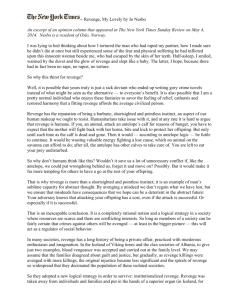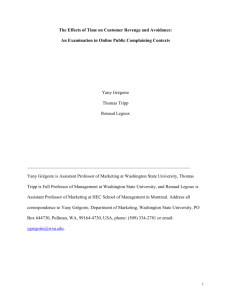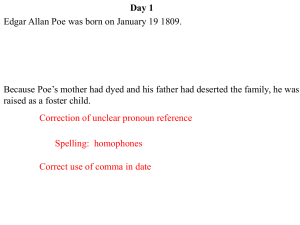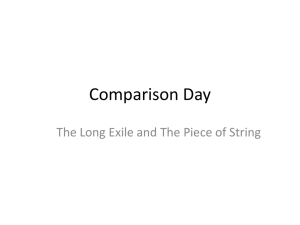Hop-Frog Analysis: Themes, Characters, and Romanticism
advertisement
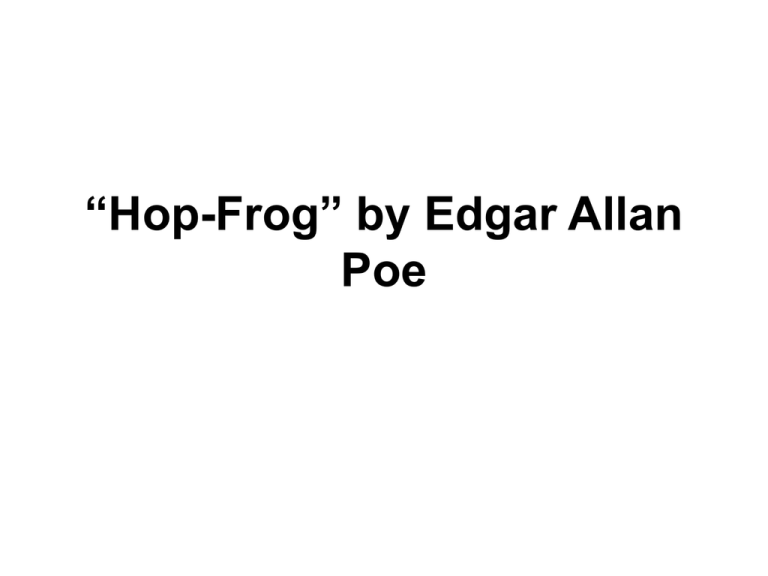
“Hop-Frog” by Edgar Allan Poe Characters: • The King and his Ministers – Has the highest status, rules over Hop-Frog and Trippetta. – They are the antagonists of the short story. – Described as ‘large, corpulent, oily’. – The King is sadistic, though he disguises it for joviality. – This can be seen through Hop-Frog, whose “value was trebled in the eyes of the king, by the fact of his being also a dwarf and a cripple”. – When Hop-Frog cries after being reminded of his ‘absent friends’, the King laughs and finds entertainment in his suffering. • King cont. – However, the King does not see his treatment of HopFrog and Trippetta as cruel. – Hop-Frog says “But just after your majesty had struck the girl and thrown the wine in her face…there came into my mind a capital diversion.” – The King does not detect any hint of revenge or sinister ideas from Hop-Frog’s statement, which suggests that he does not think there is any reason for Hop-Frog to want revenge. • They were costumed as Orangutans during the masquerade. – This is because they were a new discovery during the 19th Century, and, as much wasn’t known about them, people thought of them as beasts with brute strength and little to no intelligence at all. – Also, as they were in very convincing costumes, any feelings of remorse or sympathy the audience might have for them are erased, and replaced with a fear of these “ferocious-looking creatures”. • Hop-Frog – – – – Lower status Is oppressed by the King and his Ministers Slaves from a foreign land. He is described as a “triplicate treasure”: A fool, a cripple and a dwarf all in one. • The grating of his teeth is done right before he devises his plan for revenge and right before actually putting it into action. – Poe creates sympathy for Hop-Frog in the reader by writing about past events concerning Hop-Frog, as well as telling his back story – Repetition of the word “joke” in the opening paragraph creates tension and emphasizes Hop-Frog’s discomfort. • Trippetta – She is badly treated in the story, as she is ‘admired’ and ‘petted’, while the King and his Council humiliates her by throwing wine in her face. – When she is first introduced, only her aesthetic characteristics are described, showing that the King and his Council only think of her as a doll or showpiece, instead of an actual human being. • “Although of exquisite proportions, and a marvellous dancer” • “Grace and exquisite beauty…universally admired and petted” Main Theme(s): • Revenge – Drives the main plot and is Hop-Frog’s main reason for carrying out his actions. – Hop-Frog’s thirst for revenge mainly fuelled by the King’s mistreatment of him and Trippetta. – The “low, harsh, grating” of Hop-Frog’s teeth often accompanies his thoughts of revenge [elaborated on under the ‘Characters’ section below]. – Despite setting the country’s King and his Council on fire during a massive masquerade, Hop-Frog and Trippetta manage to escape with no persecution or consequences whatsoever. – “Together, they effected their escape to their own country; for neither was seen again.” Romanticism: • Romanticism took place during the late 18th Century and the early 19th Century and celebrated nature rather than civilisation. • A few of its characteristics are shown in Hop-Frog: Emotions over reason • Hop-Frog acts on his emotions, rather than on logic and reason. – When he burns the King and his ministers, he doesn’t think it through logically, and does what he can to protect himself and Trippetta. – After committing his act of revenge, Hop-Frog does not face any repercussions (or rather, he successfully avoids any repercussions) and escapes with Trippetta. • Their victory shows how, in this short story, emotions are more important than reason. Innocence over education/sophistication • Trippetta and Hop-Frog are ‘innocent’ and less educated than the King and his ministers who are educated and of a higher status. • The portrayal of Trippetta and Hop-Frog as dwarfs make them seem more like children, which helps in the portrayal of their innocence. • As the King and his ministers are seen as the antagonists, this shows Poe’s preference towards innocence rather than sophistication, as well as his preference towards those of lower status than those of higher status. Use of Language: • The King’s treatment of Hop-Frog worsens (he turns from a ‘king’ to a ‘tyrant’ to a ‘monster’) This makes us sympathize with him and pardons his act of revenge • Uses negative language like ‘oily’ and ‘corpulent’ to describe the King and his Ministers, which helps to present them as the antagonists. • Repetition of the word “joke” in opening paragraph creates tension and emphasizes Hop-Frog’s discomfort • Hop-Frog covers the King and his Council in tar and flax, which are symbols of humiliation and punishment throughout history. • The iron chains that the King and his Council are trapped in might also symbolise the entrapment of Hop-Frog and Trippetta, showing that Hop-Frog and Trippetta have escaped from their chains and are turning the tables on the King and his Council. • There is foreshadowing of the King and his Council’s fate earlier on in the story, when HopFrog dresses up the King and his Council as Orangutans. – “Hop-Frog passed the residue of the chain, in two diameters, at right angles, across the circle, after the fashion adopted, at the present day, by those who capture Chimpanzees, or other large apes, in Borneo.” – This hints at the ending, with Hop-Frog capturing the King and his Council, dressed as ‘apes’, with the chain. Use of Contrast: • The King has power over Hop-Frog and Trippetta in the beginning of the short story, but in the end, it is Hop-Frog who holds the King’s life in his hands. Tone: • Has a fairytale-like quality to it. • Plot is unrealistic and fantasy-like. • Very dark, horror genre. Viewpoint: • First person point-of-view – The narrator is a subject of the King’s royal court, which makes the short story a little unreliable. – He does not outright acknowledge the King’s cruelty and sadism, though he does use words like “monster” and “tyrant” to describe the King. Relation to ‘Outsiders’: • Both Hop-Frog and Trippetta are slaves from a foreign land – As they are ‘different’ (both in nationality and in appearance), they are ostracised and treated as inferior. – They are also of lower class, and serves only as entertainment for the higher classes. • Hop-Frog is not just an outsider to the other characters in the story (with the exception of Trippetta), but also an outsider to the reader him/herself. – This is because he is neither purely good nor purely evil (like how the King and his Council is portrayed). The reader does sympathise with him (especially in the beginning), but after he exacts revenge on the King and his Council, the reader can no longer identify with Hop-Frog. – Hop-Frog reduces the King and his Council to a “fetid, blackened, hideous, and indistinguishable mass”, which gives the reader conflicting thoughts about the moral stance of the protagonist. – Despite being the protagonist, Hop-Frog shows a lack of compassion or conscience, showing no regret or guilt for murdering the King and his Council. Others: • As it was written 12 years before the US Civil War, it contains anti-slavery messages Is Poe Hop-Frog? – Hop-Frog has parallels to Edgar Allan Poe’s life, where he was ‘kidnapped from home and presented to the king’ (his mother died, his father abandoned him and John Allan, his wealthy foster father, took him in). • Both Hop-Frog and Poe could not hold their alcohol. • Poe’s original father abused his mother. This parallels the King’s treatment of Trippetta. • “At last, without uttering a syllable, he pushed her violently from him, and threw the contents of the brimming goblet in her face.” • Hop-Frog’s act of revenge portrays the achievement Poe wishes he could have had were he of an older age when his father abused his mother.
